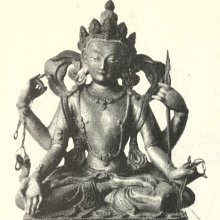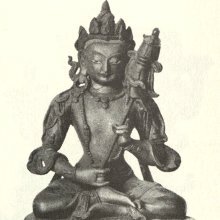Dhvajagra, Dhvajāgra, Dhvaja-agra: 6 definitions
Introduction:
Dhvajagra means something in Buddhism, Pali, Hinduism, Sanskrit. If you want to know the exact meaning, history, etymology or English translation of this term then check out the descriptions on this page. Add your comment or reference to a book if you want to contribute to this summary article.
Images (photo gallery)
In Buddhism
Mahayana (major branch of Buddhism)
Source: academia.edu: A Study and Translation of the GaganagañjaparipṛcchāDhvajāgra (ध्वजाग्र) refers to “(that which stands) on the top of a standard”, according to the Gaganagañjaparipṛcchā: the eighth chapter of the Mahāsaṃnipāta (a collection of Mahāyāna Buddhist Sūtras).—Accordingly, as Bodhisattva Gaganagañja explains to Bodhisattva Ratnaśrī what kind of concentration should be purified: “[...] (19) [when the Bodhisattvas attain] the concentration called ‘Splendor of light’, all Buddha-fields will appear. (20) [when the Bodhisattvas attain] the concentration called ‘Performing duties’, attachment and anger will be eliminated; (21) [when the Bodhisattvas attain] the concentration called ‘Ring on the top of a standard’ (dhvajāgra-keyūra-samādhi), all qualities of the Buddhas will appear; [...]”.
Source: Brill: Śaivism and the Tantric Traditions (mahayana)Dhvajāgra (ध्वजाग्र) refers to the “top of a banner”, according to the Dhvajāgrakeyūradhāraṇī.—The setting of this scripture is the celestial Trāyastriṃśat abode where Śakra requests help from the Buddha after the gods have been defeated by the Asuras, led by Vemacitrin. The lord tells Śakra to learn the invincible Dhvajāgrakeyūradhāraṇī, which he had come to know from Aparājitadhvaja Tathāgata during a previous existence. Then the Bhagavān reveals the dhāraṇī and teaches that its user becomes victorious in battles and conflicts. The spell is to be fixed atop a banner (dhvajāgra) or around the neck, and protects kings or heroic people. Manifesting as a divine female, it stands in the frontline, providing fearlessness and protection, driving the enemy away as well as granting blessings and prosperity.
Source: De Gruyter: A Buddhist Ritual Manual on AgricultureDhvajāgra (ध्वजाग्र) refers to the “top of a flagstaff” (suitable for an offering ritual), according to the Vajratuṇḍasamayakalparāja, an ancient Buddhist ritual manual on agriculture from the 5th-century (or earlier), containing various instructions for the Sangha to provide agriculture-related services to laypeople including rain-making, weather control and crop protection.—Accordingly, [As the Bhagavān said]: “Now I shall teach the offering manual which is auspicious and can bring about any effect. [...] This dhāraṇī should be written down and mounted at the top of a flagstaff (dhvajāgra) in the four corners of the maṇḍala. These should be placed in the middle of the field. These should be placed in the middle of the garden. Immediately after these have been placed, the great mountain slope sealing of the boundary is completely established in the four directions. [...]”.

Mahayana (महायान, mahāyāna) is a major branch of Buddhism focusing on the path of a Bodhisattva (spiritual aspirants/ enlightened beings). Extant literature is vast and primarely composed in the Sanskrit language. There are many sūtras of which some of the earliest are the various Prajñāpāramitā sūtras.
Languages of India and abroad
Sanskrit dictionary
Source: Cologne Digital Sanskrit Dictionaries: Edgerton Buddhist Hybrid Sanskrit DictionaryDhvajāgra (ध्वजाग्र).—nt. (= Pali dhajagga), top of a banner or standard: °grāṇy api (240.19 adds asya, v.l. cāsya) prapatetsu(ḥ; mss.) Mahāvastu i.230.10 = 240.19.
Source: Cologne Digital Sanskrit Dictionaries: Monier-Williams Sanskrit-English Dictionary1) Dhvajāgra (ध्वजाग्र):—[from dhvaja > dhvañj] n. the top of a standard (See below)
2) [v.s. ...] m. a [particular] Samādhi, [Kāraṇḍa-vyūha]
3) [v.s. ...] a [particular] Roma-vivara, [ib.]
[Sanskrit to German]
Sanskrit, also spelled संस्कृतम् (saṃskṛtam), is an ancient language of India commonly seen as the grandmother of the Indo-European language family (even English!). Closely allied with Prakrit and Pali, Sanskrit is more exhaustive in both grammar and terms and has the most extensive collection of literature in the world, greatly surpassing its sister-languages Greek and Latin.
See also (Relevant definitions)
Partial matches: Dhvaja, Agra.
Starts with: Dhvajagrakeyura, Dhvajagrakeyuradharani, Dhvajagramani, Dhvajagranishamani, Dhvajagranishravani, Dhvajagrasutra, Dhvajagravati.
Full-text: Dhvajagranishamani, Dhvajagrakeyura, Dhvajagravati, Nishamani, Keyura, Keyurasamadhi.
Relevant text
Search found 1 books and stories containing Dhvajagra, Dhvajāgra, Dhvaja-agra; (plurals include: Dhvajagras, Dhvajāgras, agras). You can also click to the full overview containing English textual excerpts. Below are direct links for the most relevant articles:
Maha Prajnaparamita Sastra (by Gelongma Karma Migme Chödrön)
II. All the recollections drive away fear < [Part 1 - Position and results of the recollections]
Introduction to third volume < [Introductions]

